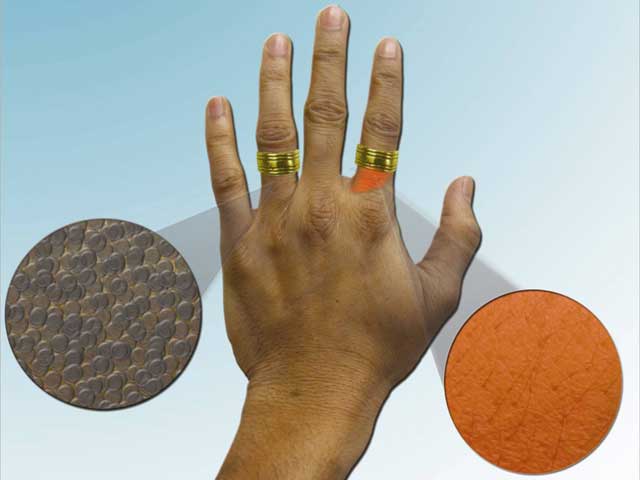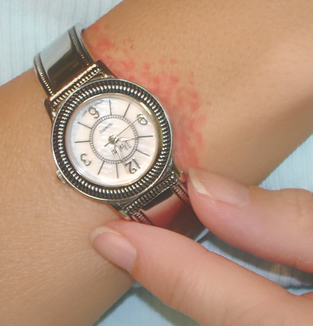 Nickel is a silvery-white lustrous metal with a slight golden tinge. Nickel belongs to the transition metals and is hard and ductile. Pure nickel shows a significant chemical activity that can be observed when nickel is powdered to maximize the exposed surface area on which reactions can occur, but larger pieces of the metal are slow to react with air at ambient conditions due to the formation of a protective oxide surface. Even then, nickel is reactive enough with oxygen so that native nickel is rarely found on Earth's surface, being mostly confined to the interiors of larger nickel–iron meteorites that were protected from oxidation during their time in space. On Earth, such native nickel is always found in combination with iron, a reflection of those elements' origin as major end products of supernova nucleosynthesis. An iron–nickel mixture is thought to compose Earth's inner core.
Nickel is a silvery-white lustrous metal with a slight golden tinge. Nickel belongs to the transition metals and is hard and ductile. Pure nickel shows a significant chemical activity that can be observed when nickel is powdered to maximize the exposed surface area on which reactions can occur, but larger pieces of the metal are slow to react with air at ambient conditions due to the formation of a protective oxide surface. Even then, nickel is reactive enough with oxygen so that native nickel is rarely found on Earth's surface, being mostly confined to the interiors of larger nickel–iron meteorites that were protected from oxidation during their time in space. On Earth, such native nickel is always found in combination with iron, a reflection of those elements' origin as major end products of supernova nucleosynthesis. An iron–nickel mixture is thought to compose Earth's inner core.The use of nickel (as a natural meteoric nickel–iron alloy) has been traced as far back as 3500 BC. Nickel was first isolated and classified as a chemical element in 1751 by Axel Fredrik Cronstedt, who initially mistook its ore for a copper mineral. The element name comes from a mischievous sprite of German miner's mythology, Nickel (similar to Old Nick), that personified the fact that copper-nickel ores resisted refinement into copper. Nickel's most important modern ore minerals are laterites, including limonite, garnierite, and pentlandite. Major production sites include Sudbury region in Canada (which is thought to be of meteoric origin), New Caledonia in the Pacific and Norilsk in Russia.
Because of nickel's slow rate of oxidation at room temperature, it is considered corrosion-resistant. Historically this has led to its use for plating metals such as iron and brass, to its use for chemical apparatus, and its use in certain alloys that will retain a high silvery polish, such as German silver. About 6% of world nickel production is still used for corrosion-resistant pure-nickel plating. Nickel was once a common component of coins, but has largely been replaced by cheaper iron for this purpose, especially since the metal has proven to be a skin allergen for some people.
Nickel is one of the four elements that are ferromagnetic around room temperature. Alnico permanent magnets based partly on nickel are of intermediate strength between iron-based permanent magnets and rare-earth magnets. The metal is chiefly valuable in the modern world for the alloys it forms; about 60% of world production is used in nickel-steels (particularly stainless steel). Other common alloys, as well as some new superalloys, make up most of the remainder of world nickel use, with chemical uses for nickel compounds consuming less than 3% of production. As a compound, nickel has a number of niche chemical manufacturing uses, such as a catalyst for hydrogenation. Enzymes of some microorganisms and plants contain nickel as an active center, which makes the metal an essential nutrient for them.
Nickel is used in many specific and recognizable industrial and consumer products, including stainless steel, alnico magnets, coinage, rechargeable batteries,Phone Keypads, electric guitar strings, microphone capsules, and special alloys. It is also used for plating and as a green tint in glass. Nickel is preeminently an alloy metal, and its chief use is in the nickel steels and nickel cast irons, of which there are many varieties. It is also widely used in many other alloys, such as nickel brasses and bronzes, and alloys with copper, chromium, aluminium, lead, cobalt, silver, and gold (Inconel, Incoloy, Monel, Nimonic).
Toxicity
 In the US, the minimal risk level of nickel and its compounds is set to 0.2 µg/m3 for inhalation during 15–364 days. Nickel sulfide fume and dust are believed to be carcinogenic, and various other nickel compounds may be as well. Nickel carbonyl, [Ni(CO)4], is an extremely toxic gas. The toxicity of metal carbonyls is a function of both the toxicity of the metal as well as the carbonyl's ability to give off highly toxic carbon monoxide gas, and this one is no exception; nickel carbonyl is also explosive in air. Sensitized individuals may show an allergy to nickel, affecting their skin, also known as dermatitis. Sensitivity to nickel may also be present in patients with pompholyx. Nickel is an important cause of contact allergy, partly due to its use in jewellery intended for pierced ears. Nickel allergies affecting pierced ears are often marked by itchy, red skin. Many earrings are now made nickel-free due to this problem. The amount of nickel allowed in products that come into contact with human skin is regulated by the European Union. In 2002, researchers found amounts of nickel being emitted by 1 and 2 Euro coins far in excess of those standards. This is believed to be due to a galvanic reaction.
In the US, the minimal risk level of nickel and its compounds is set to 0.2 µg/m3 for inhalation during 15–364 days. Nickel sulfide fume and dust are believed to be carcinogenic, and various other nickel compounds may be as well. Nickel carbonyl, [Ni(CO)4], is an extremely toxic gas. The toxicity of metal carbonyls is a function of both the toxicity of the metal as well as the carbonyl's ability to give off highly toxic carbon monoxide gas, and this one is no exception; nickel carbonyl is also explosive in air. Sensitized individuals may show an allergy to nickel, affecting their skin, also known as dermatitis. Sensitivity to nickel may also be present in patients with pompholyx. Nickel is an important cause of contact allergy, partly due to its use in jewellery intended for pierced ears. Nickel allergies affecting pierced ears are often marked by itchy, red skin. Many earrings are now made nickel-free due to this problem. The amount of nickel allowed in products that come into contact with human skin is regulated by the European Union. In 2002, researchers found amounts of nickel being emitted by 1 and 2 Euro coins far in excess of those standards. This is believed to be due to a galvanic reaction.
Jewelry Allergy (Nickel Allergy)
Jewellery Allergy or Nickel Allergy are terms used to denote skin reactions arising due to jewelry or nickel. If the skin gets exposed to allergens or irritants present in jewelry or nickel, then there is every chance to get one’s skin feeling itching or irritation and appearance of rashes or inflammation.
Nickel: An Allergen
There is a sometimes a risk of contact dermatitis from gold jewelry, though one may not have a history of allergy to gold. Metal smiths sometimes mix a very small amount of nickel in with gold to prepare it for metalwork, since pure gold is much too soft to be suitable for the making of jewelry. When one’s ear lobe is pierced with a needle and the gold stud or ring is put on, one’s skin has been exposed to the metal alloy that irritates it or that causes an allergic reaction in the form of rash or inflammation. The wound will not heal until the allergy causing item is removed. The patient then usually requires treatment for the skin rash or inflammation. Any jewelry made out of nickel, regardless if it is used plain or to create an alloy, will trigger contact dermatitis.==Skin Exposed to Nickel== According to some dermatologists, exposure of skin to an allergen for as little as 12 to 24 hours could be sufficient for irritation, rashes and inflammation to develop. Based on the location of the inflammation on one’s body, the physician may be able to determine the source of irritant. Reportedly, even foods cooked in stainless steel cookware may cause an allergic reaction in some individuals.
Nickel allergy and cells phones
Cell phone dermatitis is on the rise. A new form of nickel allergy (allergic contact dermatitis to nickel) on the face and ears is appearing after using phones which contain nickel.
It appears that trendier fashionable cell phones often have metallic accents which contain free nickel. When possible, researchers recommended nickel sensitive individuals test cell phones for nickel content before purchasing.
- Coating the area with Nickel Guard—3 thin coats is very effective on non-movable parts.
- Use the speakerphone or headset.
The duration and conditions of use greatly influence the likelihood of a reaction. Prolonged contact especially in warmer environments enhances nickel transfer to the skin and will intensify the rash.
For people with a metal allergy, it is possible to still wear jewelry, but a little extra care must be given. Cheap jewelry almost always contains nickel, and must be avoided. Even jewelry that is marketed as gold or silver may contain nickel, as this metal is often added to gold and silver to harden them. Even seemingly harmless items such as the metal buttons on jeans, a buckle on a watch, and even a metal-coated keypad on a cell phone can irritate the skin wherever they come into contact with it.
There is no allergy medication that can cure a metal allergy, but precautions can be taken to minimize or prevent the discomfort. Any time the wearer notices a rash developing, the cause must be removed as soon as possible. Topical steroids can be an effective allergy treatment, but must be prescribed by a doctor. Emollient creams offer another form of treatment, but all they can do is to relieve the itching of the rash, not prevent it. Plastic covers can be purchased for earring studs to enable someone with a metal allergy to wear cheaper earrings, but the common approach of painting earring studs or necklace chains with clear nail polish is not advised, as sweat and moisture will quickly dissolve it. Living with a metal allergy is difficult at times, because it requires the person to anticipate whenever metal might come into contact with their skin long enough to cause an allergic reaction. However, with a little foresight and planning, it is possible for someone with a metal allergy to avoid discomfort and still lead a normal life.
Living with a metal allergy is difficult at times, because it requires the person to anticipate whenever metal might come into contact with their skin long enough to cause an allergic reaction. However, with a little foresight and planning, it is possible for someone with a metal allergy to avoid discomfort and still lead a normal life.





